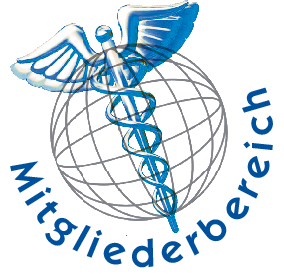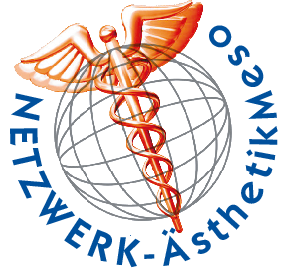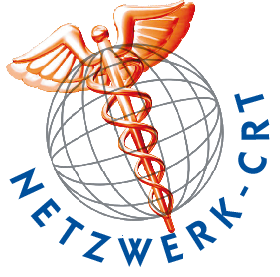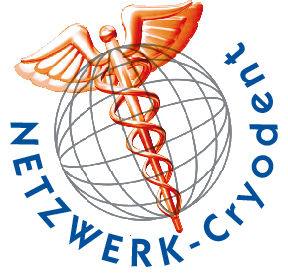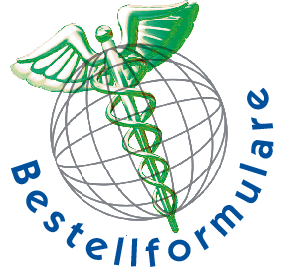NETWORK – Globalhealth
Informationen für Ärzte

Fachbereich Injektions-Lipolyse
Informationen zum Standardprotokoll der Injektions-Lipolyse / Fett-Weg-Spritze und zur Mitgliedschaft
Arztsuche
Falls Sie wissen möchten, welche zertifizierten Ärzte aus Ihrer Region eine entsprechende Behandlung anbieten, nutzen Sie gerne unsere neue Google gestützte Arztsuche.
Patienteninformation
Achtung! Diese Seite richtet sich ausschließlich an Ärzte.
Für Patienten, die sich zu den von uns angebotenen Therapien informieren möchten, haben wir einen speziell auf Ihre Bedürfnisse zugeschnittenen Bereich geschaffen:
Zu den Patienteninformationen
Hinweis für Ärzte
Die im Folgenden aufgeführten Informationen ersetzten keinesfalls ein umfassendes Hands-On Training zur Injektions-Lipolyse. Erst durch die auf unseren Workshops vermittelten theoretischen und praktischen Erfahrungen kann eine Behandlung sicher und effizient durchgeführt werden.
Themennavigation
Der Fachbereich Injektions-Lipolyse ist der älteste und gleichzeitig umfangreichste Fachbereich innerhalb des Netzwerk Ästhetik. Neben der Standard-Therapie der Injektions-Lipolyse beschäftigt sich dieser Fachbereich zusätzlich mit sämtlichen minimal-invasiven Therapien zur gezielten Reduktion kleinerer Fettpolster.
Die Entwicklung des Fachbereichs Injektions-Lipolyse
Das übergeordnete Ziel dieses 2003 noch als NETZWERK-Lipolyse gegründeten Fachbereichs war die Entwicklung eines standardisierten Therapie-Protokolls für die damals noch weitestgehend unbekannte Injektions-Lipolyse, auch Fett-Weg-Spritze genannt. Das erarbeitete Konzept fand international so großen Zuspruch, dass eine baldige Kooperation mit den Universitäten Bochum und Regensburg zahlreiche wissenschaftliche Publikationen zu diesem neuartigen minimal-invasiven Behandlungs-Ansatz hervorbrachte.
Seither sieht der Fachbereich seine Hauptaufgabe darin, das Standard-Protokoll beständig zu verbessern und das bereits erarbeitete Wissen an approbierte Ärzte weiterzugeben.
Neben der Entwicklung unserer Skin Attitude Produkt-Reihe zur Optimierung der Nachsorge von Patienten wurden mehrfach Erhebungen zur Zufriedenheit und Verträglichkeit der Therapie sowie etwaiger Komplikationen durchgeführt.
Durch diese stetige Weiterentwicklung ist die Injektions-Lipolyse inzwischen nicht nur so sicher wie noch nie, wir konnten auch ihre Effektivität und Anwendungsmöglichkeiten erheblich ausweiten.

Die Grundlagen der Therapie
Wirkmechanismen
Die Injektions-Lipolyse ist eine minimal-invasive ästhetische Therapie zur gezielten Reduktion kleinerer regional begrenzter Fettpolster. Hierzu wird das von uns entwickelte Compound subkutan in das betreffende Fettgewebe injiziert. Die Adipozyten werden dadurch aufgelöst und das austretende Fett mithilfe von Lipasen zur Leber transportiert, wo es durch Enzyme aufgespalten und anschließend in den Mitochondrien zum Energieträger Adenosintriphosphat (ATP) verstoffwechselt.
Die durch die Injektion ausgelöste Entzündungsreaktion sorgt im Nachgang für einen natürlichen Straffungseffekt der Haut und des darunterliegenden Gewebes. Anders als bei anderen Behandlungsmethoden handelt es sich hierbei also nicht um eine temporäre Lösung durch das schlichte verkleinern bestehender Fettzellen, sondern um deren komplette Entfernung.
Im Gegensatz zur Liposuktion liefert die Injektions-Lipolyse eine gleich- wie auch ebenmäßige Schmälerung der Körper-Silhouette. Nicht selten wird die Injektions-Lipolyse daher auch im Nachgang zu einer Liposuktion durchgeführt, um bleibende Unebenheiten auszugleichen.

Wirkstoffe
Das innerhalb des Fachbereichs verwendete Compound besteht zum Großteil aus Polyenylphosphatidylcholin (kurz PPC), einer hochgereinigten Molekülkombination aus der Familie der Lecithine, Desoxycholsäure (DOC) als Lösungsmittel und dem Konservator Benzylalkohol. Die Rezeptur dieses verschreibungspflichtigen Gemischs basiert auf dem ursprünglich zur Behandlung von Fettembolien entwickelten Medikament Lipostabil.
Wie durch Studien mehrfach belegt wurde, reduziert das gelöste PPC nicht nur die Toxizität der Desoxycholsäure, sondern fördert gleichzeitig die Metabolisierung des freigesetzten Fetts.
Durch die Mischung zu gleichen Teilen mit einem separaten Vitamin-B-Komplex entsteht schließlich unser Standard-Compound, welches Inhalt sämtlicher Fortbildungen zur diesem Thema ist. In speziellen Fällen wie beispielsweise der Behandlung von Lipomen kann die PPC/DOC-Mischung auch in Reinform injiziert werden.
Seit Neuestem steht auch eine optionale Lösung in Form des Nano PPC 500 zur Verfügung, welches exklusiv von der Viktoria Apotheke in Saarbrücken hergestellt wird. Hierbei wurde die Molekülgröße des bekannten PPC auf 40-60 nm reduziert und in Glycyrrhizinsäure statt wie bisher in DOC gelöst.
Das Nano PPC 500 eignet sich vor allem für kleinere Fettpolster insbesondere im Gesichtsbereich.
Standard-Protokoll
Das ausschließlich auf den von uns organisierten Workshops gelehrte Standard-Protokoll umfasst zunächst eine ausführliche Einführung in die Wirkweise und Anwendung der Injektions-Lipolyse mit anschließendem Hands-On Training an von uns organisierten Probanden. Gleichzeitig stehen aber auch essenzielle Inhalte wie Patientenselektion, Aufklärung sowie die optimale Nachsorge der Patienten auf dem Kursplan.
Sollten Sie sich für eine unserer CME-zertifizierten Fortbildungen interessieren, finden Sie kommende Termine auf der Terminübersicht unserer Globalhealth Academy.
Veröffentlichungen
Lipolyse Report
Bereits seit 2004 führt der Fachbereich regelmäßig statistische Erhebungen zu Patientenzufriedenheit und möglichen Komplikationen durch, um auf Auffälligkeiten reagieren und das Behandlungsprotokoll weiter optimieren zu können.
Beim letzten sogenannten Lipolyse-Report flossen 74.000 Einzelbehandlungen von insgesamt 29.889 Patienten in die Auswertung ein.
Demnach gaben 90% der Patienten an, zufrieden bis sehr zufrieden mit den vorgenommenen Gesichtsbehandlungen zu sein; bei den Körperbehandlungen waren es immerhin 85%.
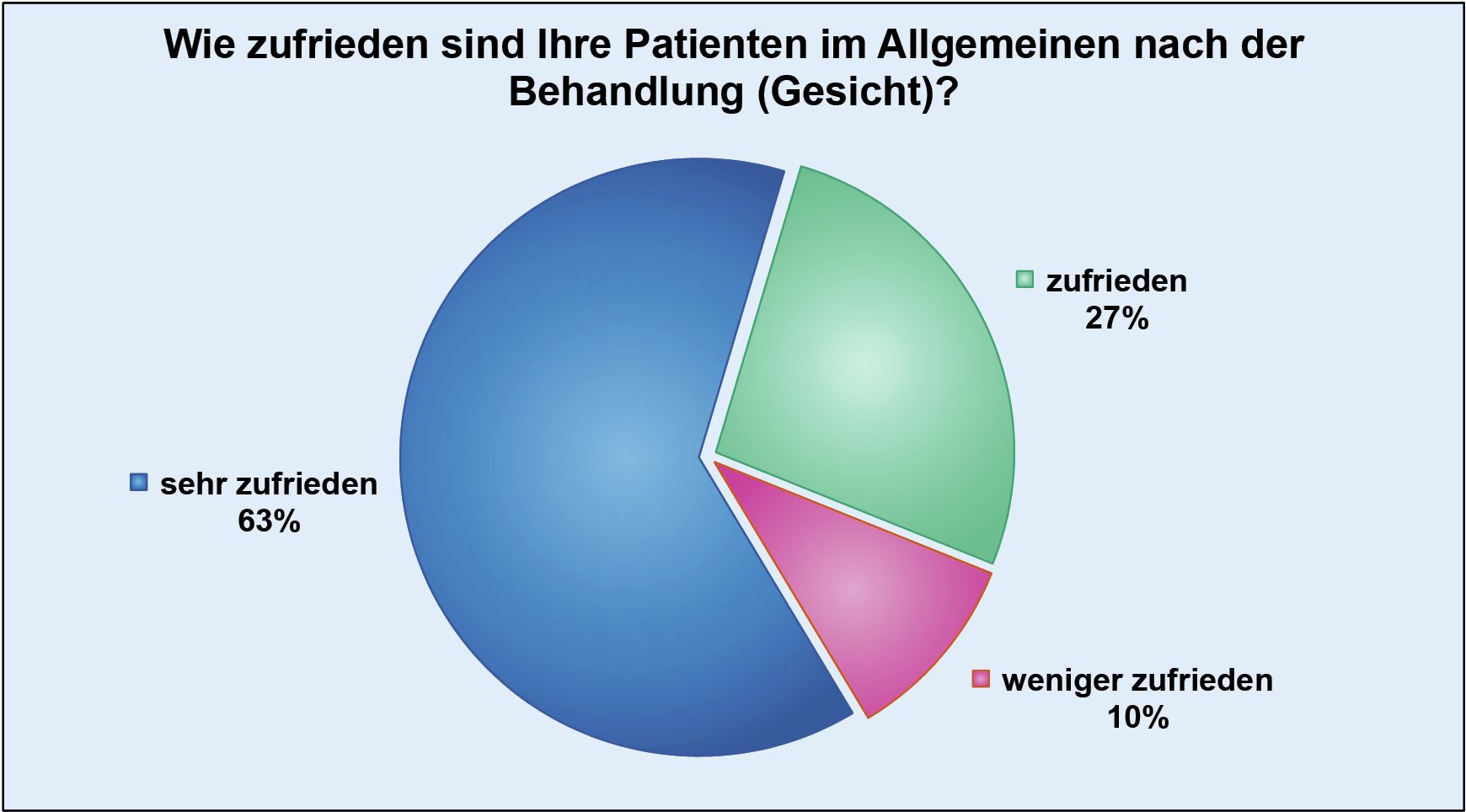
Das gesamte Fachbereichs-Team ist sehr stolz auf diese Ergebnisse und arbeitet beständig darauf hin, die Patientenzufriedenheit noch weiter zu steigern.
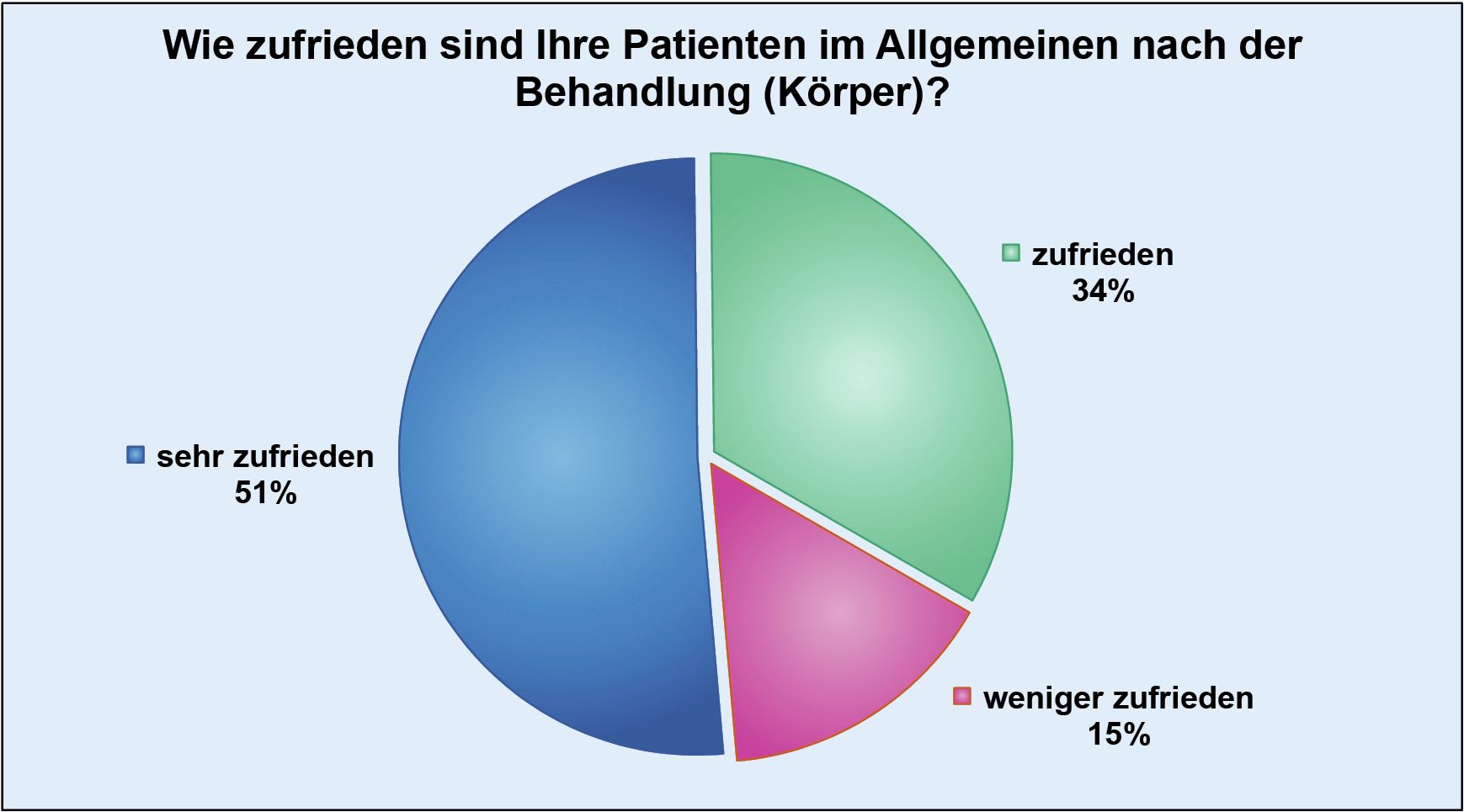
Durch die hohen Standards, die wir an die Durchführung der Injektions-Lipolyse-Therapie anlegen, konnten wir auch die Zahl möglicher Komplikationen auf ein Minimum reduzieren.
So traten bei gerade einmal 0,1 Promille (0,01%) der Patienten Nekrosen auf, welche im Einzelfall tatsächlich auf mangelnde Sorgfalt der Betroffenen bei der Nachsorge zurückgeführt werden konnten. Fast identisch niedrig liegt der Wert der dokumentierten Abszesse mit 0,2 Promille (0,02%).
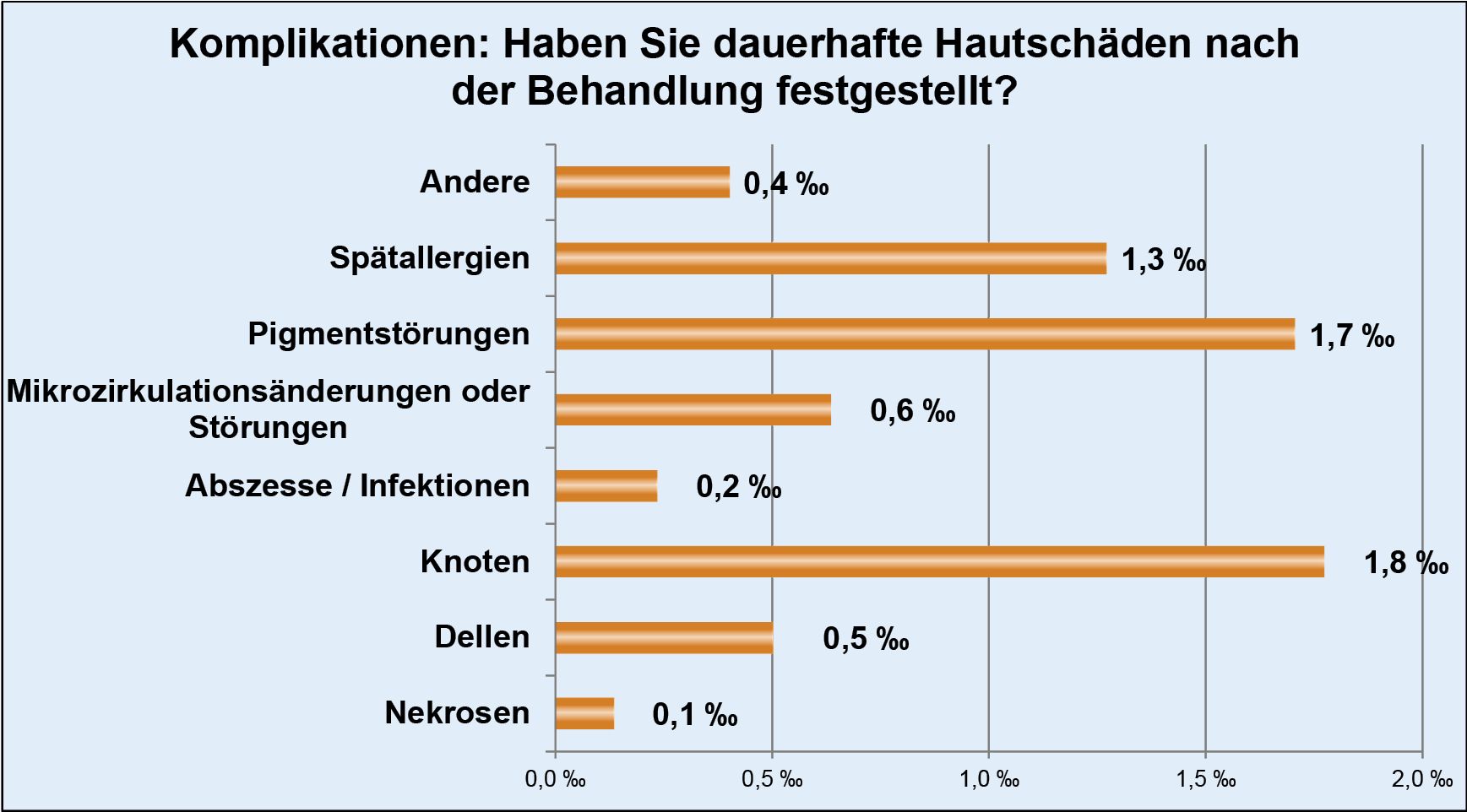
Da jedoch jede einzelne Komplikation, sei sie reversibel oder nicht, immer noch eine zu viel ist, legen wir viel Wert darauf, unsere Ärzte für eine ausführliche und anschauliche Aufklärung im Patientengespräch zu sensibilisieren.
Literaturliste
Falls Sie sich im Vorfeld zu einer unserer CME-zertifizierten Fortbildungen bereits eigenständig mit der Materie vertraut machen wollen, haben wir uns erlaubt, eine ausführliche Literaturliste zur Injektions-Lipolyse zusammenzustellen.
nur Publikationen, die das Thema Injektions-Lipolyse behandeln
Ablon G, Rotunda AM: Treatment of lower eyelid fat pads using phosphatidylcholine: clinical trial and review. Dermatol. Surg. 2004; 30: 422-7
Adelson H: Management of side effects and adverse reactions from injection of phosphatidylcholine. Am. J. Mesotherapy 2006; 5: 16-7
Atiyeh BS, Ibrahim AE, Dibo SA: Cosmetic mesotherapy between scientific evidence, science fiction, and lucrative business. Aesthet. Plast. Surg. 2008; 32: 842-9
Avelar JM: Comment on “refinement of technique in injection lipolysis based on scientific studies and clinical evaluations”. Clin. Plast. Surg. 2009; 36: 211-3
Bates B: ‘Fat dissolving’ substance injects CCs of controvery: despite growing U.S. interest, Lipostabil’s safety remains uncertain, experts warn. Skin & Allergy News 2003; 34: 1
Baumann L: Cosmeceutical critique: phosphatidylcholine. Skin & Allergy News 2003; 34: 24-5
Bechara FG, Mannherz HG, Jacob M, Mazur AJ, et al: Induction of fat cell necrosis in human fat tissue after treatment with phosphatidylcholine and deoxycholate. JEADV 2012; 26: 180-5
Bechara FG, Georgas D, Sand M, Tomi N, et al: Incapsulated fat necrosis after lipolysis of the calf with phosphatidylcholine. Dermatology 2008; 216: 180-1
Bechara FG, Skrygan M, Kreuter A, Altmeyer P, et al: Cytokine mRNA levels in human fat tissue after injection lipolysis with phosphatidylcholine and deoxycholate. Arch. Dermatol. 2008; 300: 455-9
Bechara FG, Sand M, Hoffmann K, Sand D, et al: Fat tissue after lipolysis of lipomas: a histopathological and immunohistochemical study. J. Cutan. Pathol. 2007; 34: 552-7
Bechara FG, Sand M, Sand D, Rooterdam S, et al: Lipolysis of lipomas in patients with familial multiple lipomatosis: an ultrasonography-controlled trial. J. Cutan. Med. Surg. 2006; 10: 155-9
Bechara FG, Sand M, Altmeyer P, Hoffmann K: Intralesional lipolysis with phosphatidylcholine for the treatment of lipomas: pilot study. Arch. Dermatol. 2006; 142: 1069-70
Bellman B: Phosphatidylcholine reaction. Skin & Allergy News 2003; 34: 12
Brown SA: Commentary on: Metabolic and structural effects of phosphatidylcholine and deoxycholate injections on subcutaneous fat: a randomized, controlled trial. Aesthet. Surg. J. 2013; 33: 409-10
Brown SA: The science of mesotherapy: chemical anarchy. Aesthet. Surg. J. 2006; 26: 95-8
Bryant R: Controversial mesotherapy: could it be the next botox? Dermatol. Times 2004; 25: 1
Chase CC: Common complications and adverse reactions in a mesotherapy practice. Am. J. Mesotherapy 2006; 1: 14-5
Chung SJ, Chung HL, Ho SL, Sung TK, et al: The role of phosphatidylcholine and deoxycholic acid in inflammation. Life Sci. 2014, http://dx.doi.org/10.1016/j.lfs.2014.05.013
Co AC, Abad-Casintahan MF, Espinoza-Thaebtharm A: Submental fat reduction by mesotherapy using phosphatidylcholine alone vs. phosphatidylcholine and organic silicium: a pilot study. J. Cosm. Dermatol. 2007; 6: 250-7
De Paula Mesquita T, de Almeida HL, de Paula Mesquita MC: Histological resolution of naevus lipomatosus superficialis with intralesional phosphatidylcholine. JEADV 2009; 23: 714-5
Dobrodin A: The treatment for eye pads revealed. Am. J. Mesotherapy 2006; 1: 16-7
Doerr TD: Lipoplasty of the face and neck. Curr. Opin. Otolaryngol. Head Neck Surg. 2007; 15: 228-32
Duncan DI: Commentary on: Metabolic and structural effects of phosphatidylcholine and deoxycholate injections on subcutaneous fat: a randomized, controlled trial. Aesthet. Surg. J. 2013 33: 411-3
Duncan DI: Letter to the editor – Response to “injection lipolysis with phosphatidylcholine and deoxycholate”. Aesthet. Surg. J. 2013; 33: 1073-5
Duncan D, Rotunda AM: Injectable therapies for localized fat loss: state of the art. Clin. PLast. Surg. 2011; 38: 489-501, vii
Duncan D, Rubin JP, Golitz L, Badylak S, et al: Refinement of technique in injection lipolysis based on scientific studies and clinical evaluation. Clin. Plast. Surg. 2009; 36: 195-209,v-vi; discussion 211-3
Duncan DI, Palmer M: Fat reduction using phosphatidylcholine/sodium deoxycholate injections: standard of practice. Aesthetic Plast. Surg. 2008; 32: 858-72
Duncan DI: The role of phosphatidylcholine in non-surgical body contouring. In: Aesthetic Mesotherapy and Injection Lipolysis in Clinical Practice, edt. by Sh.Madhère. Replika press Pvt, Ltd./India 2007: chapter 8: 61-75
Duncan DI, Chubaty R: Clinical safety data and standards of practice for injection lipolysis: a retrospective study. Aesthet. Surg. J. 2006; 26: 575-85
Duncan DI, Hasengschwandtner F: Lipodissolve for subcutaneous fat reduction and skin retraction. Aesthet. Surg. J. 2005; 25: 530-43
Friedland JA: Comment on “mesotherapy and injection lipolysis”. Clin. Plast. Surg. 2009; 36: 193
Frisari P, Pinto R: Mesosculpt with phosphatidylcholine. Am. J. Mesotherapy 2006; 6: 9
Fritz K, Tiplica G-S: Kosmet. Med. 2011; 32: 280-6
Göller A: Lipolyse in der plastischen Chirurgie. Dissertation, Ulm 2011
Gupta A, Lobocki C, Singh S, Robertson M, et al: Actions and comparative efficacy of phosphatidylcholine formulation and isolated sodium deoxycholate for different cell types. Aesthet. Plast. Surg. 2009; 33: 346-52
Hasegawa T, Matsukura T, Ikeda S: Mesotherapy for benign symmetric lipomatosis. Aesthet. Plast. Surg. 2010; 34: 153-6
Hasengschwandtner F, Gundermann K: Injection lipolysis with phosphatidylcholine and deoxycholate. Aesthet. Surg. J. 2013; 33: 1071-2
Hasengschwandtner F: Statistische Auswertung einer Befragung der Ärzte des NETZWERK-Lipolyse. Kosmet. Med. 2013; 34: 29-30
Hasengschwandtner F, List P, Spannbauer M: Objektive Messung der Körperzusammensetzung nach Injektionslipolyse mit Polyenylphosphatidylcholin mittels DEXA-Methode (Dual-Energy X-Ray-Absorptiometrie). Kosmet. Med. 2010; #5: 246-52
Hasengschwandtner F: Fat melting injections – The latest scientific findings, terms and methods. Kosmet. Med. 2009; #2: 10-5
Hasengschwandtner F, Brandl D: Phosphatidylcholine. NETWORK-Lipolysis, 2009, http://www.network-lipolysis.com/index.php?id=1513
Hasengschwandtner F: Injection lipolysis: a new method of body contouring. In: Handbook of Cosmetic Skin Care – 2nd Edition, e3dt. By A.Shai, H.I.Maibach, R.Baran, Repikla press Pvt Ltd./India, 2009; chapter 13: pp. 102-5
Hasengschwandtner F: Altersbedingte Fettgewebsveränderungen: Lipolyse, Cellulitebehandlung. In: Hautalterung – Grundlagen, Prävention, Therapie, edt. By
J.Krutmann, T.Diepgen and C.Billmann-Krutmann, Springer press, Heidelberg 2008, chapter 10: pp. 151-165
Hasengschwandtner F, Furtmueller F, Spanbauer M, Silye R: Detailed documentation of one lipolysis treatment: blood values, histology, and ultrasound findings. Aesthet. Surg. J. 2007; 27: 204-11
Hasengschwandtner F: Injection lipolysis for effective reduction of localized fat in place of minor surgical lipoplasty. Aesthet. Surg. J. 2006; 26: 125-30
Hasengschwandtner F: Fat melting injections. Am. J. Mesotherapy 2006; 6: 24-25
Hasengschwandtner F: The subcutaneous injection of phosphatidylcholine for means of lipolysis. Lipodissolve – The non surgical liposculpture. Akt. Dermatol. 2005; 31: 549-52
Hasengschwandtner F: Phosphatidylcholine treatment to induce lipolysis. J. Cosmet. Dermatol. 2005; 4: 308-13
Heinrich K-G: Efficacy of injection of phosphatidylcholine into fat deposits – a non-surgical alternative to liposuction in body-contouring. Indian J. Plast. Surg. 2005; 38: 119-22
Heinrich KG: Injection lipolysis with phosphatidylcholine. Cosmet. Med. 2004; #5-6: 238-40
Hexsel DM, Serra M, de Oliveira Dal’Forno T, Zechmeister do Prado D: Cosmetic uses of injectable phosphatidylcholine on the face. Otolaryng. Clin. N. Am. 2005; 38: 1119-29
Hexsel D, Serra M, Mazzuco R, de Oliveira Dal’Forno T, et al: Phosphatidylcholine in the treatment of localized fat. J. Drugs Dermatol. 2003; 2: 511-8
Hoffmann K: Injection lipolysis. Hautarzt 2010; 61: 847-55
Hoffmann K, Altmeyer P: Verfahren zur Körperformung. In: Ästhetische und plastische Operationen in der Dermatologie, W3L-press/Herdecke/Witten, 2007; chapter 6.1-6.3
Hui KC: Body contouring by liposculpture. The Hong Kong Medical Diary 2008; 13: 20-3
Hübner N-F, Horch RE, Polykandriotis E, Rau TT, Dragu A: A histopathologic and immunohistochemical study on liquification of human adipose tissue ex vivo. Aesth. Plast. Surg. 2014; 38: 976-84
Hübner NF: Adipocytolyse durch Lipostabil®: Ex vivo Untersuchungen an humane Gewebe (Adipocytolysis by Lipostabil® ex vivo investigations with human tissue). Dissertation July 11, 2012
Hunstad JP, De Souza M: Review of “the lipodissolve technique: clinical experience” and author’s comment. Clin. Plast. Surg. 2009; 36: 223-6
Hunter NS, El Tawdy AM, Hegazy RA, El Samanoudy SI, et al: Letter: A 15-patient pilot trial of lipolysis of the hips and thighs using a phosphatidylcholine and deoxycholate formulation. Dermatol. Surg. 2013; 39: 791-4
Janke J, Engeli S, Gorzelniak K, Luft FC: Compounds used for ‘injection’ lipolysis destroy adipocytes and other cells found in adipose tissue. Obes. Facts 2009; 2: 36-9
Kardorff B, Gansel RW, Tats R, Balzer L, et al: 2004 Lipodissolve Clinical Report http://www.asal-meso.com/html/news/june_1B_2005_news.htm
Karolchyk S, Seibert L: Detergent effects of sodium deoxycholate are a major feature of an Injectable phosphatidylcholine formulation used for localized fat dissolution: a review. Am. J. Mesotherapy 2006; 1: 18-9
Kato M, Watanabe T, Yamada N, Yoshida Y, et al: Mixed cell granulomatous panniculitis on the cheek due to injection of a solution containing phosphatidylcholine and deoxycholate. Dermatol. Surg. 2010; 36: 1779-81
Khan MH, Victor F, Rao B, Sadick NS: Treatment of cellulite – Part II. Advances and controversies. J. Am. Acad. Dermatol. 2010; 62: 373-384
Kim HS, Park YM, Kim HO, Lee JY: Intralesional phosphatidylcholine and sodium deoxycholate: a possible treatment option for nevus lipomatosus superficialis. Ped. Dermatol. 2012; 29: 119-21
Kirn TF: Injection lipolysis is both defended, criticized: ‘we’ve been using injection lipolysis in my clinic for 2 years now and getting excellent results’. Skin & Allergy News 03/01/08
Klein SM, Schreml S, Nerlich M, Prantl L: In vitro studies investigating the effect of subcutaneous phosphatidylcholine injections in the 3T3-L1 adipocyte model: lipolysis or lipid dissolution? Plast. Reconstr. Surg. 2009; 124: 419-27
Klein SM, Prantl L, Berner A, Schreml S, et al: A new method to quantify the effect after subcutaneous injection of lipolytic substances. Aesthet. Plast. Surg. 2008; 32: 667-72; discussion 673-4
Kopera D, Horejsi R, Werner S, Moeller R: Injektionslipolyse zur Reduktion von seitlich im Bereich des Trochanters gelegenen Fettdepots („Reithosen”) – kontrollierte Halbseiten-Pilotstudie. JDDG 2008; 6: 287-291
Kopera D, Binder B, Toplak H, Kerl H, et al: Histopathologic changes after intralesional application of phosphatidylcholine for lipoma reduction – report of a case. Am. J. Dermatopathol. 2006; 28: 331-3
Kopera D, Binder B, Toplak H: Intralesional lipolysis with phosphatidylcholine for the treatment of lipomas: pilot study. Arch. Dermatol. 2006; 142: 395-6
Kutlubay Z: Evaluation of mesotherapeutic injections of three different combinations of lipolytic agents for body contouring. J. Cosmet. Laser Ther. 2011; 13: 142-53
Kyong YY, Choi KH: Woman with hemorrhagic spots on her abdomen. Clin. Toxicol. 2013; 51: 804-5
Le Coz J, Rittes PG: Guidelines and limitations on the use of phosphatidylcholine (Lipostabil) in mesotherapy. Am. J. Mesotherapy 2006; 2: 6-7
Levy SLJ: Tratamiento de la adiposidad localizada con fosfatidilcolina subcutánea a diferentes concentraciones. Una evaluación histological de su efecto. Dissertation, Mexico October 2013
Li H, Lee J-H, Kim SY, Yun H-Y: Phosphatidylcholine induces apoptosis of 3T3-L1 adipocytes. J. Biomed. Sci. 2011; 18: 91
Madhère S: Mesotherapy in the management of cellulite. In: Aesthetic Mesotherapy and Injection Lipolysis in Clinical Practice, edt. by S.Madhère, Informa Healthcare Replika press Pvt Ltd./India 2007; chapter 10: 85-98
Mahmud K, Crutchfield CE: Lipodissolve for body sculpting - safety, effectiveness, and patient satisfaction. J. Clin. Aesthet. Dermatol. 2012; 5: 16-9
Maggiori S: Traitement mésothérapique des xanthelasmas à la phosphatidilcoline polyinsaturée. 5th Cong. Int. Mésothérapie, Paris/France 1988, Oct.07-09, p.364
Mann MW, Palm MD, Sengelmann RD: New advances in liposuction technology. Semin. Cutan. Med. Surg. 2008; 27: 72-82
Matarasso A, Pfeifer TM: Mesotherapy and injection lipolysis. Clin. Plast. Surg. 2009; 36: 181-92
Matarasso A, Pfeifer TM, and the Plastic Surgery Educational Foundation DATA Committee: Mesotherapy for body contouring. Plast. Reconstr. Surg. 2005; 115: 1420-4
McNamara D: Lipolysis melts away appearance of double chin. Skin & Allergy News 04/01/09
McNamara D: Data validate some lipolysis, but not mesotherapy. Skin & Allergy News 2006; 37: 20
McNamara D: Mesotherapy gaining ground as surgery-free fat reducer. Skin & Allergy News 2005; 36: 17
Meißner T: Spritze rückt Fettpolstern und Lipomen zu Leibe. Ärzte Zeitung 04.03.2011
Mokosch A, Mota R, Gerber PA, Homey B: Severe toxic dermatitis after injection lipolysis. Der Hautarzt 2012; 63: 282-5
Môle B: A five years experience of subcutaneous chemical lipolysis with phosphatidylcholine injections. Ann. Chir. PLast. Esthét. 2011; 56: 112-9
Motolese P: Phospholipids do not have lipolytic activity. A critical review. J. Cosmet. Laser Ther. 2008; 10: 114-8
Myers P: The cosmetic use of phosphatidylcholine in the treatment of localized fat deposits. Cosmet. Dermatol. 2006; 19: 416-20
Nanda S: Treatment of lipomas by injection lipolysis. J. Cutan. Aesthet. Surg. 2011; 4: 135-7
Noh Y, Heo C-Y: The effect of phosphatidylcholine and deoxycholate compound injections to the localized adipose tissue: an experimental study with a murine model. Arch. Plast. Surg. 2012; 39: 452-6
Noreldin AA, Abd Elhamid AM, Hashem AM, Afifi AM: A pilot study on the use of injection lipolysis in visceral adipose tissues. Aesthet. Surg. J. 2013 33: 431-5
Olbertz F-W: Injektionslipolyse – ein Erfahrungsbericht nach einjähriger Anwendung. Frauenarzt 2007; 48: 576-7
Ono S, Hyakusoka H: Complications after self-injection of hyaluronic acid and phosphatidylcholine for aesthetic purposes. Aesthet. Surg. J. 2010; 30: 442-7
Palmer M, Curran J, Bowler P: Clinical experience and safety using phosphatidylcholine injections for the localized reduction of subcutaneous fat: a multicentre, retrospective UK study. J. Cosmet. Dermatol. 2006; 5: 218-26
Palumbo P, Melchiorre E, La Torre C, Miconi G, et al: Effects of phosphatidylcholine and sodium deoxycholate on human primary adipocytes and fresh human adipose tissue. Int. J. Immunopath. Pharmacol. 2010; 23: 481-9. Erratum 2010; 23: 970
Park E-J, Kim H-S, Kim M, Oh H-J: Histological changes after treatment for localized fat deposits with phosphatidylcholine and sodium deoxycholate. J. Cosmet. Dermatol. 2013; 12: 240-3
Peckitt N: Evidenced Based Practice: Phosphatidylcholine – A Review of Evidence for the Mode of Action in Injection Lipolysis. Jeremy Mills Publishing Ltd., Huddersfield, UK, 2005, ISBN: 9781905217137
Pindur L, Sand M, Altmeyer P, Bechara FG: Recurrent growth of lipomas after previous treatment with phosphatidylcholine and deoxycholate. J. Cosmet. Laser Ther. 2011; 13: 95-6
Rallis E, Kintzoglou S, Moussatoo V, Riga P: Mesotherapy-induced urticaria – Letter to the Editor. Dermatolo. Surg. 2010; 36: 1355-7
Reeds DN, Mohammed S, Klein S, Boswell CB, et al: Metabolic and structural effects of phosphatidylcholine and deoxycholate injections on subcutaneous fat: a randomized, controlled trial. Aesthet. Surg. J. 2013; 33: 400-8. Comments by Brown SA: Aesthet. Surg. J. 2013; 33: 409-10 & Duncan D: Aesthet. Surg. J. 2013; 33: 411-3
Rein P: Injektionslipolyse mit Phosphatidylcholin – Erfahrungen mit der „Fett-Weg-Spritze“. Der Deutsche Dermatologe 2006; #9: 619-20
Rey JW, Schreiner O, Barreiros AP, Heise M, et al: Z. Gastroenterol. 2011; 49: 340-3
Rha EY, Kang JA, Lee JH, Oh DY, et al: Comparative analysis about the effect of isolated phosphatidylcholine and sodium deoxycholate for the viability of adipocyte. J. Korean Soc. Plast. Reconstr. Surg. 2010; 37: 531-4
Rittes PG, Rittes C: Treatment of aging neck with „Lipostabil“ endovena. J. Drugs Dermatol. 2009; 8: 937-9
Rittes PG: The lipodissolve technique: clinical experience. Clin. Plast. Surg. 2009; 36: 215-21
Rittes PG: Non-surgical body contouring: the Brazilian experience. In: Aesthetic Mesotherapy and Injection Lipolysis in Clinical Practice, edt. by Sh.Madhère, Replika press, Pvt. Ltd./India 2007; chapter 9, pp. 77-83
Rittes PG: Complications of Lipostabil endovena for treating localized fat deposits. Aesthet. Surg. J. 2007; 27: 146-9
Rittes PG, Rittes J, Amary MFC: Injection of phosphatidylcholine in fat tissue: experimental study of local action in rabbits. Aesthetic Plast. Surg. 2006; 30: 474-8
Rittes PG: The use of phosphatidylcholine for correction of localized fat deposits. Am. J. Mesotherapy 2006; 2: 8-11
Rittes PG: The use of phosphatidylcholine for correction of localized fat deposits. Aesthetic Plast. Surg. 2003; 27: 315-8
Rittes PG: The use of phosphatidylcholine for correction of lower lid bulging due to prominent fat pads. Dermatol. Surg. 2001; 27: 391-2
Rose PT, Morgan M: Histological changes associated with mesotherapy for fat dissolution. J. Cosmet. Laser Ther. 2005; 7: 17-9
Rotunda AM: Injectable treatments for adipose tissue: terminology, mechanism, and tissue injection. Lasers Surg. Med. 2009; 41: 714-20
Rotunda AM: Injectable treatments for adipose tissue: terminology, mechanism, and tissue interaction. Lasers Surg. Med. 2009; 41: 714-20
Rotunda AM, Weiss SR, Rivkin LS: Randomized double-blind clinical trial of subcutaneously injected deoxycholate versus a phosphatidylcholine-deoxycholate combination for the reduction of submental fat. Dermatol. Surg. 2009; 35: 792-803
Rotunda A: Scientific studies aim to dispel controversy surrounding injection lipolysis. The European Aesthetic Guide Autumn 2008, 74 – 84
Rotunda AM: Scientific studies aim to dispel controversy surrounding injection lipolysis. The European Aesthetic Guide, Autumn 2008; 76-84; www.euroabg.com
Rotunda AM: Mesotherapy and injection lipolysis. In: Facial Rejuvenation – A Total Approach, edt. by D.J.Goldberg, Springer press Berlin Heidelberg 2007; chapter 7: 147-65
Rotunda AM, Kolodney MS: Mesotherapy and phosphatidylcholine injections: historical classification and review. Dermatol. Surg. 2006; 32: 465-80
Rotunda AM, Ablon G, Kolodney MS: Lipomas treated with subcutaneous deoxycholate injections. J. Am. Acad. Dermatol. 2005; 53: 973-8
Rotunda AM, Avram MM, Avram AS: Cellulite: Is there a role for injectables? J. Cosmet. Laser Ther. 2005; 7: 147-54
Rotunda AM, Suzuki H, Moy RL, Kolodney MS: Detergent effects of sodium deoxycholate are a major feature of an injectable phosphatidylcholine formulation used for localized fat dissolution. Dermatol. Surg. 2004; 30: 1001-8
Salles AG, Valler CS, Ferreira MC: Histologic response to injected phosphatidylcholine in fat tissue: experimental study in a new rabbit model. Aesthet. Plast. Surg. 2006; 30: 479-84
Salti G, Ghersetich I, Tantussi F, Bovani B et al: Phosphatidylcholine and sodium deoxycholate in the treatment of localized fat: a double-blind, randomized study. Dermatol. Surg. 2008; 34: 60-6
Salti G, Rauso R: Comments on “Injection Lipolysis with phosphatidylcholine and deoxycholate”. Aesthet. Surg. J. 2014; 34: 639-40
Schuller-Petrovic S, Wölkart G, Höfler G, Neuhold N, et al: Tissue-toxic effects of phosphatidylcholine/deoxycholate after subcutaneous injection for fat dissolution in rats and a human volunteer. Dermatol. Surg. 2008; 34: 529-43
Sobel HD: Editorial – Off-label usage of medical devices. Int. J. Cosm. Surg. Aesthet. Dermatol. 2002; 4: 259
Steinert M: Injektionslipolyse. DERMAforum 2009; #1: 4
Strahan JE, Cohen JL, Chorny JA: Granuloma annulare as a complication of mesotherapy: a case report. Dermatol. Surg. 2008; 34: 836-8
Tanner B, Barabas T, Crook D, Link C: A future for injection lipolysis. Aesthet. Surg. J. 2013; 33: 456-7
Tausch I, Kruglikov I (2015) The benefit of dualfrequency ultrasound in patients treated by injection lipolysis, journal of clinical and aesthetic. Dermatology(Basel) 8(8):42–46
Tawfik HA, Zuel-Fakkar NMA, Wlmarasy R, Talib N, et al: Phosphatidylcholine for the treatment of prominent lower eyelid fat pads: a pilot study. Ophthal. Plast. Reconstr. Surg. 2011; 27: 147-51
Toledo LS: a) Preface b) Emerging techniques in aesthetic plastic surgery. Clin. Plast. Surg. 2009; 36: a) xi-xiii b) 177-80
Treacy PJ, Goldberg DJ: Use of phosphatidylcholine for the correction of lower lid bulging due to prominent fad pads. J. Cosmet. Laser Ther. 2006; 8: 129-32
Uygur F, Evinç R, Duman H: Is phosphatidylcholine harmful to the peripheral neural tissue? An experimental study in rats. Aesthet. J. Surg. 2008; 28: 663-7
Walsh N: Some would halt lipolysis Tx pending safety data. Skin & Allergy News 2004; 35: 26
Weidmann M, Lettko M, Prantl L (2016) Injektionslipolyse, J .Ästhet Chir DOI 10.1007/s12631-016-0047-2
Weiss DD, Carraway JH: Eyelid rejuvenation: a marriage of old and new. Curr. Opin. Otolaryngol. Head Neck Surg. 2005; 13: 248-54
Witort EJ, Pattarino J, Romano FM, Dini M, et al: Lipolytic effectiveness of phosphatidylcholine in the treatment of ‘buffalo hump’ of HIV patients. J. Plast. Reconstr. Aesthet. Surg. 2011; 64: e26-8
Won TJ, Nam Y, Lee HS, Chung S, et al: Injection of phosphatidylcholine and deoxycholic acid regulates gene expression of lipolysis-related factors, pro-inflammatory cytokines, and hormones on mouse fat tissue. Food Chem. Toxicol. 2013; 60: 263-8
Wong GR, Chen W-P: Phosphatidylcholine/deoxycholate lipolysis and hyaluronic acid augmentation to enhance nonsurgical lower facial contouring using botulinum toxin type A. J. Cosmet. Dermatol. 2011; 10: 159-62
Worcester S: Lipodissolve mesotherapy is gaining popularity. Skin & Allergy News 2007; 38: 25
Young VL: Letter to the editor – Response to “injection lipolysis with phosphatidylcholine and deoxycholate”. Aesthet. Surg. J. 2013; 33: 1076
Young VL: Lipostabil: the effect of phosphatidylcholine on subcutaneous fat. Aesthet. Surg. J. 2003; 23: 413-7
Zhang Y, Gao J-h, Jiang P, Wang L-y, et al: Chin. J. Aesthet. Med. 2006; 15: 1346-8


